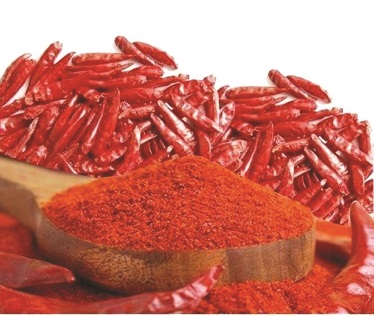
What are chili Peppers?
Chili peppers (Capsicum annuum) are the fruits of Capsicum pepper plants, notable for their hot flavor. They are members of the nightshade family, linked to bell peppers and tomatoes. We have different types of chili peppers, such as cayenne and jalapeño. Chili peppers are normally used as a spice and can be cooked or dried and powdered. Powdered, red chili peppers are known as paprika. Capsaicin is the main bioactive plant compound in chili peppers, responsible for their unique, pungent taste and many of their health benefits. Not only do these spicy superfoods contain a whole host of antioxidants, but chili peppers also have been shown to improve digestive health, reduce blood pressure levels and bump up fat-burning.
Chili peppers have their roots in Vietnamese, Mexican, Indian, Thai, Arabic, and Spanish dishes, among others. It has been established from history, that chili peppers are mainly used to treat a variety of different ailments. For instance, the Mayans, used chili peppers to treat respiratory conditions like asthma and coughing, while the Aztecs used peppers to provide relief from toothaches. Other jurisdictions use chili peppers to treat headaches, stiff joints, heart
Different varieties
One study by Gómez-García et al.(2013) found that theantioxidant content of mature (red) chili peppers is much higher than that of immature (green) peppers. Additionally, diverse chili peppers exist on the market. some are mild chili peppers, such as sweet bell peppers, to Carolina Reaper peppers, hailed as the world’s hottest chili pepper. It has been established that the heat of these peppers is considered by the chili pepper Scoville scale, whichexamines and records the spiciness of peppers in Scoville Heat Units (SHU) based on their content of capsaicinoids. Apart from the heat, differences in color and size exist. For instance, the Aji Cristal pepper is a small chili pepperfamous for its animated red color. Equally, the Holy Mole pepper is another type of green chili pepper that can grow up to nine inches long.
Below are some of the chili peppers:
Bell pepper
Poblano pepper
Aleppo pepper
Holy Mole pepper
Cayenne pepper
Chiltepin pepper
Banana pepper
Jalapeño pepper
Aji Cristal pepper
Ghost chili pepper
Anaheim chili pepper
Serrano pepper
Thai chili pepper
Nutritional Compounds
Link, R (2020) explains in her article that specific nutrients and compounds found in chili peppers can vary based on the different pepper varieties, most are rich in a range of vitamins, minerals, and antioxidants. In particular, chili peppers are high in vitamin C, folate, and vitamin A, along with a host of other important micronutrients.
USDA notes that one half-cup of red chili pepper contains the following nutrients:
30 calories
6.5 grams carbohydrates
1.5 grams protein
0.5 grams fat
1 gram dietary fiber
108 milligrams vitamin C (180 percent Daily Value (DV)
0.4 milligrams folate (19 percent DV)
714 International Units vitamin A (14 percent DV)
10.5 micrograms vitamin K (13 percent DV)
241 milligrams potassium (7 percent DV)
0.1 milligrams manganese (7 percent DV)
0.1 milligrams copper (5 percent DV)
0.9 milligrams niacin (5 percent DV)
Hot peppers are also rich in other beneficial compounds, including antioxidants, such as capsaicin, which is responsible for providing peppers with their signature spicy flavor. Peppers also contain other antioxidants and carotenoids as espoused by: Gómez-García et al. 2013; Kim et al. 2009; Rodríguez-Burruezo et al. 2010; Deli et al. 2001; Abdel-Aal et al. 2013; Nićiforović and Abramovič, 2013; Materska et al. 2003; Srinivasan et al. 2007):
Lutein: abundant in green (immature) chili peppers, lutein’s levels reduce with maturation. High consumption of lutein is linked to improved eye health.
Antheraxanthin: is a bright yellow accessory pigment found in many organisms that perform photosynthesis
Capsanthin- The main carotenoid in red chili peppers — up to 50% of the total carotenoid content — capsanthin is responsible for their red color. Its powerful antioxidant properties may fight cancer.
Ferulic acid:Similarly, to sinapic acid, ferulic acid is an antioxidant that may help protect against various chronic diseases.
Capsorubin: belongs to the class of organic compounds known as triterpenoids. These are terpene molecules containing six isoprene units. Thus, capsorubin is considered to be an isoprenoid.
Beta-cryptoxanthin: a common carotenoid that is found in fruit, blood, and tissues.
Zeaxanthin: a type of organic pigment called a carotenoid. It’s related to vitamin A and is found in the human eye (macula and retina) along with lutein. Zeaxanthin is thought to function as a light filter, protecting the eye tissues from sunlight damage.
Beta-carotene: a pigment found in plants that gives them their color. The name beta-carotene is derived from the Latin name for carrot. It gives yellow and orange fruits and vegetables their rich types. Beta-carotene is also used to color foods such as margarine.
Violaxanthin: The major carotenoid antioxidant in yellow chili peppers, violaxanthin accounts for 37–68% of the total carotenoid content.
Capsaicin: One of the most studied plant compounds in chili peppers, capsaicin is responsible for its pungent (hot) flavor and many of its health effects.
Sinapic acid: Also known as sinapinic acid, this antioxidant has a variety of potential health benefits.
Chili Pepper, Science
Pain relief
As explained in this article, Capsaicin, is the majorbioactive plant compound in chili peppers, with diverse novel properties. For instance, Chung et al.(2016) affirmed that diverse studies have been conducted and foundthat chili peppers could potentially help provide relief from pain. What capsaicin does is that it binds with pain receptors, which are nerve endings that sense pain. This induces a burning sensation but does not cause any real burning injuries. In one article by Arnarson, A (2019), the author explained that high consumption of chili peppers (or capsaicin) may desensitize pain receptors over time, reducing your ability to sense the burning flavor of chili. Additionally, it also makes these pain receptors insensitive to other forms of pain, such as heartburn caused by acid reflux. For instance, one previous clinical trial by Bortolotti et al.(2002) found that when 2.5 grams of red chili peppers were given daily to people with heartburn, the pain deteriorated at the beginning of the 5-week treatment but enhanced over time. Jutaghokiat et al.(2009) affirmed this exposition and found that 3 grams of chili each day enhanced heartburn in people with acid reflux for 6 weeks. A previous study by Karrer and Bartoshuk(1995) found that the desensitization effect is not permanent, as it was reversed in 1–3 days after capsaicin consumption stopped.
Chili Pepper, Blood Pressure
Emerging studies opined that chili peppers have the potential to lower blood pressure to help keep your heart at bay. For instance, Schutte et al.(2014) suggest that chili pepper does this due to the compound capsaicin which enhances levels of insulin-like growth factor 1 (IGF-1), a very significant hormone that could dilate the blood vessels to offer defense against high blood pressure.
In another study, Harada and Okajima(2009) found that giving capsaicin and isoflavone (another beneficial plant compound) to those with high blood pressure proved effective at increasing levels of IGF-1 and reducing both systolic and diastolic blood pressure. Likewise, Yang et al(2010) animal study found that eating capsaicin has the potential to trigger a precise protein tangled in regulating blood pressure, and in turn avert high blood pressure levels.
Chili Pepper, digest health
It has been established in naturopathic medicine that, chili peppers treat many numerous digestive conditions, including indigestion, acid reflux, stomach ulcers, and loss of appetite. For instance, one study by Maji and Banerji(2016) found that over 200 natural compounds were recognized in these influential peppers. Additionally, the study found chilican to regulate gastric secretions, fight pathogens in the digestive tract, strengthen the defense mechanisms of the stomach, and stimulate digestion.
One review by Satyanarayana et al. (2006) found that capsaicin per se cantreat and avert stomach ulcers. The review further established that capsaicin can inhibit acid secretion, improve mucus secretion and enhance blood flow in the stomach to aid enhance ulcers and wounds.
Take Home
It is interesting how ingredients in our local foods have immersed health benefits on our health yet we are not aware of them. Empirical studies have demonstrated the immersed benefits of these ingredients which are also found in our kitchen. The interesting one is how Jun et al.(2015) and Chopan and Littenberg’s (2017) studies linked consuming hot peppers to longevity which is found in our local foods.
NB:
Prof. Nyarkotey has strict sourcing guidelines and relies on peer-reviewed studies, academic research institutions, and medical associations to justify his write-ups. My articles are for educational purposes and do not serve as Medical advice for Treatment. I aim to educate the public about evidence-based scientific Naturopathic Therapies.
By Prof. Raphael Nyarkotey Obu
The writer is a Professor of Naturopathic Healthcare, President, Nyarkotey College of Holistic Medicine & Technology (NUCHMT)/African Naturopathic Foundation.
E-mail: collegeofholisticmedicine@gmail.com.




